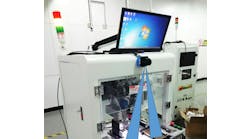When starting up a new control system as a machine builder or servicing production equipment as a system integrator, there are a wide variety of diagnostic tools used. These are often reactive tools used to identify problems as they occur during commissioning or system troubleshooting. However, once in production, digital connections and the Internet of Things (IoT) are using sensors, measurement devices and vision systems for proactive diagnostics, as well.
The seasoned electrical engineer, electrician or technician may have a tool cabinet full of diagnostic tools to test many machine and process variables. These tools span the range from power and discrete level testing in a control panel to analog instrument setup and calibration. Additionally, the IoT is adding network diagnostic tools and even predictive diagnostic applications in the cloud.
A must-have diagnostic tool is the digital multimeter (DMM) to measure ac/dc voltage, ac/dc current and resistance. A clamp-on current-tester accessory is also helpful for currents over 10 A or so. In addition, a built-in diode and continuity tester, with audible beep, is a useful feature during testing. Some DMMs have frequency and capacitance measurement capabilities that a few users may need. When testing an electrical circuit, the ability to stand up the meter or hang it can also improve readability by the user. And make sure it can handle at least 600 V.
Another great addition to the diagnostic toolbox is the oscilloscope. It is nearly a must-have to sort out encoder signal hardware and wiring problems, especially with the quadrature devices. It is also useful to test or understand transducer or load-cell response in a dynamic-system test by providing a high-resolution view of the signal showing oscillation, overshoot and undershoot in high-speed applications.
A variety of oscilloscope form factors are available from a multi-channel tabletop device to a PC-based system. They are also available embedded in many applications such as robotics, motion control and PLC programming platforms. These applications are graphically displaying position and velocity motion profiles, PID temperature response trends and more. These are valuable tools to understand system performance.
As the machine moves more to the process side, add a signal generator with 4-20 mA and 0-10 V analog output for PLC input, instrumentation and proportional valve testing. Be sure the signal generator is suitable to simulate two-wire loop source and four-wire current sources.
Single-point infrared thermometers and thermal imaging cameras are another area of diagnostics. Running a motor too hard and a loose wire are just two of the many problems that can cause excess heat but are easy to detect with the proper tools.
Technology adds diagnostic tools for communications. A wide variety of cable and protocol testers are available. Many are focused to a single protocol or hardware platform but can quickly help diagnose a problem with a network. Also, network monitors, protocol analyzers and packet sniffers are available for Ethernet. All can help the user to understand problems with network traffic and can display the traffic in real time. Wireshark is a software application and good example of how network protocol and packet analysis can help troubleshoot the traffic on a problem network. Sometimes there is too much traffic or a traffic hog on the network, and these tools can help to find the culprit.
The diagnostic tools don't need to be in the engineer's or technician's hand either. Future-ready machines should embed more sensors to help to monitor it. Presence, position, force, speed, temperature, pressure, flow and vibration sensors are just a few of the methods used to understand machine or process operation, and they enable future diagnostic tools—machine learning and analytics.
With the IoT, machines and process should be instrumented up, which can provide proactive diagnostics tools called predictive maintenance. It is definitely OK to predict a problem proactively before it needs to be diagnosed reactively, after a problem occurs. This includes discrete sensors and analog transducers.
IO-Link can turn a digital on or off signal from a photo eye or inductive sensor to an exchange of data. A device’s serial number, configuration, detailed diagnostics or status is included. This data can help to diagnose an issue, such as a dirty lens on a photo eye or battery low on a smart device.
Diagnostic tools are endless and are often a starting point for continuous improvement. The problem or issue needs to be observed by human or machine, and the data needs to be viewed as actionable information. An HMI alarm screen is a must-have. However, that data can be sent to the cloud, as well. Once there, it can be available to all. It can also be analyzed by applications in the cloud and returned to the machine as usable diagnostic information before a problem occurs.
The tried and true diagnostic tools will always be needed, but the automation world is changing. Add the technology and more information to your diagnostic tool box.






